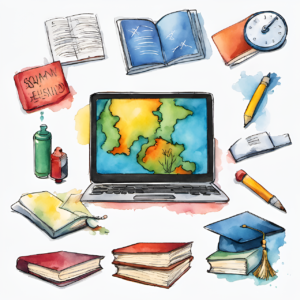Digital citizenship could be controversial within the realm of an educator. I feel that the online world was not a topic that was focused on as much when I was a young grasshopper, it was around as I remember there being computer classes and a computer room we visited, but technology was still evolving. there was a bit of a disconnect between the ‘real’ world and the online world, as I remember I would spend many hours on our home computer using MSN and allowing it to invoke my life for many hours talking to my friends. After reading the article Character Education for the Digital Age by Jason Ohler, I was surprised to read that it gives the “two lives” perspective and after reading it I was a little more shocked this perspective had mentioned that technology does not belong in the classroom. In my opinion, based on my experience and having been in a classroom both as a student and assistant, I don’t think that this notion is realistic or beneficial to students or our society.
“One Life” Perspective & Dual Digitalism Can it be done?
Another lens mentioned within the article is the “one life” perspective. Through this, we can recognize that it’s our responsibility as educators to help our students understand our digital world and bring them as much knowledge as we can with respecting boundaries. This perspective encourages us to bring together both our digital and physical lives, with believing there is no separating between both worlds. I feel the common misconception there is is that as humans we are not able to have both of those elements work in harmony, but in Nathan Jurgenson’s article “The IRL Fetish” He discusses the possibilities to exist in both worlds. As future educators, it is unrealistic for us to expect our stud ents to be completely unplugged from technology, when in reality we as educators do not even do that. we often will find our cellphones on us, or require computers and technology to help us teach our classrooms, as life goes on it is coming next to impossible to stray away from digital imprints.
ents to be completely unplugged from technology, when in reality we as educators do not even do that. we often will find our cellphones on us, or require computers and technology to help us teach our classrooms, as life goes on it is coming next to impossible to stray away from digital imprints.
The 9 Elements of Digital Citizenship & How to Incorporate Them into the Classroom
This policy planning guide is based on The Nine Elements of Digital Citizenship by Mike Ribble, which include; along with ways to incorporate them into education.
- Digital Etiquette – Having discussions about appropriate ways to conduct yourself on the internet, ensuring they are developmentally appropriate.
- Digital Access – Facilitating discussion on who has access to certain platforms and that even if we think things are private they are not.
- Digital Law – Understanding rules stating within the digital world, and reviewing the outcomes of things such as cyberbullying, sexting, etc.
- Digital Communication & Collaboration – Discuss that technology has the ability to create many different perspectives, and it is important to be mindful what you say on the internet. Whether that is Facebook, TikTok, etc.
- Digital Literacy – Teach students about different credible sources, and teach them to reference two or more sources.
- Digital Commerce – Educate students on scams and fraud, and what they might look like online, Marketplaces, banking online, etc.
- Digital Rights & Responsibilities – Teaching students that they are responsible for thier online digital profiles, and they have the right to privacy, and they need to stay protected.
- Digital Safety & Security – Educating children on things such as viruses, different sites that can damage your computer, and that clicking on everything is ok, it can create many problems within technology.
- Digital Health & Wellness – Ensuring we are using the digital world in a positive and healthy manner, not engaging in cyberbullying, looking at inappropriate sites, etc.
I believe that it’s important for all of these elements to be incorporated into the curriculum throughout all grade levels, being mindful as to what is developmentally appropriate, the faster we incorporate the better hold we will have on children understanding the digital world.
Digital Citizenship in the Classroom
In conclusion, I believe strongly that these elements should be incorporated into our curriculums, so we are preparing our students with knowledge and understanding on how to be safe in our forever evolving technological world, also ensuring us as future educators are also learning. I am interested to hear what everyone else’s idea’s on how to incorporate these elements into the classroom.

I think the one life perspective is much more important than the two life perspective. Everything is becoming digital nowadays – lessons, doctors visits, banking, etc. We need to teach students how to navigate it rather than shield them from it!
This is such a relatable reflection! I love how you acknowledge the shift from seeing the online world as separate to recognizing that digital and real life are now one. The “one life” perspective makes so much sense, technology is a huge part of our lives, so teaching students how to navigate it responsibly is essential. The breakdown of the nine elements is super helpful too! Great work!!